Cognitive Psychology: Information Processing & Memory (Tasks 1-3)
VerifiedAdded on 2023/01/06
|14
|4226
|90
Homework Assignment
AI Summary
This cognitive psychology assignment delves into three key tasks. Task 1 examines the similarities between human and computer information processing, focusing on the Atkinson and Shiffrin Information Processing Model, and exploring how the brain and computers handle information. It also investigates the reasons behind human memory loss in relation to how computers lose data. Task 2 compares and contrasts the Hierarchical and Spreading Activation models of memory organization, providing diagrammatic descriptions of each. Task 3 is not fully present in the provided text, but it likely addresses the criteria and pre-requisites for walking and state agreement/disagreement on the issue. The assignment covers memory processes, information processing, and the organization of knowledge within the human mind, as well as drawing parallels between human and computer systems. The assignment provides a comprehensive overview of core concepts in cognitive psychology and how these concepts relate to information processing and memory.
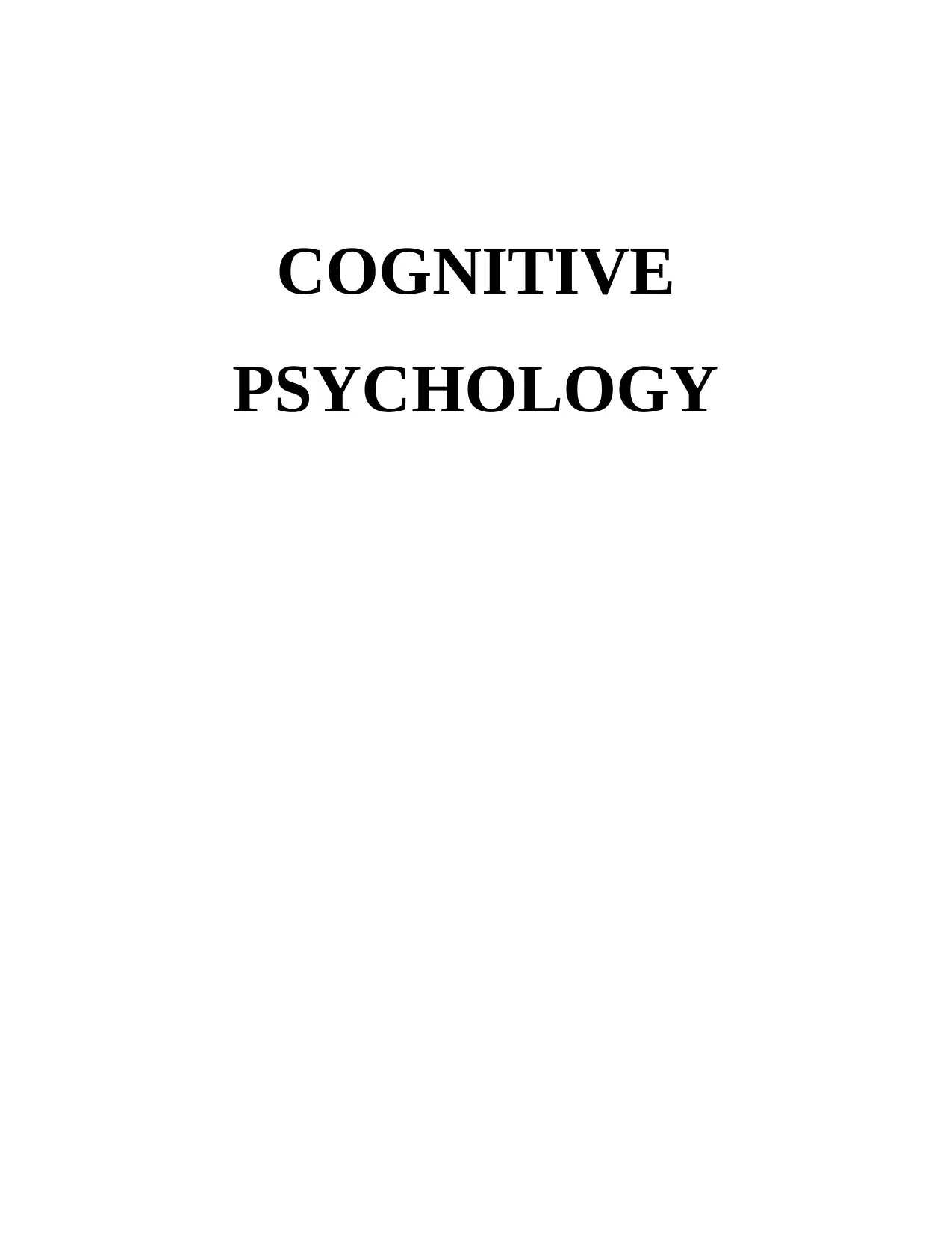
COGNITIVE
PSYCHOLOGY
PSYCHOLOGY
Paraphrase This Document
Need a fresh take? Get an instant paraphrase of this document with our AI Paraphraser
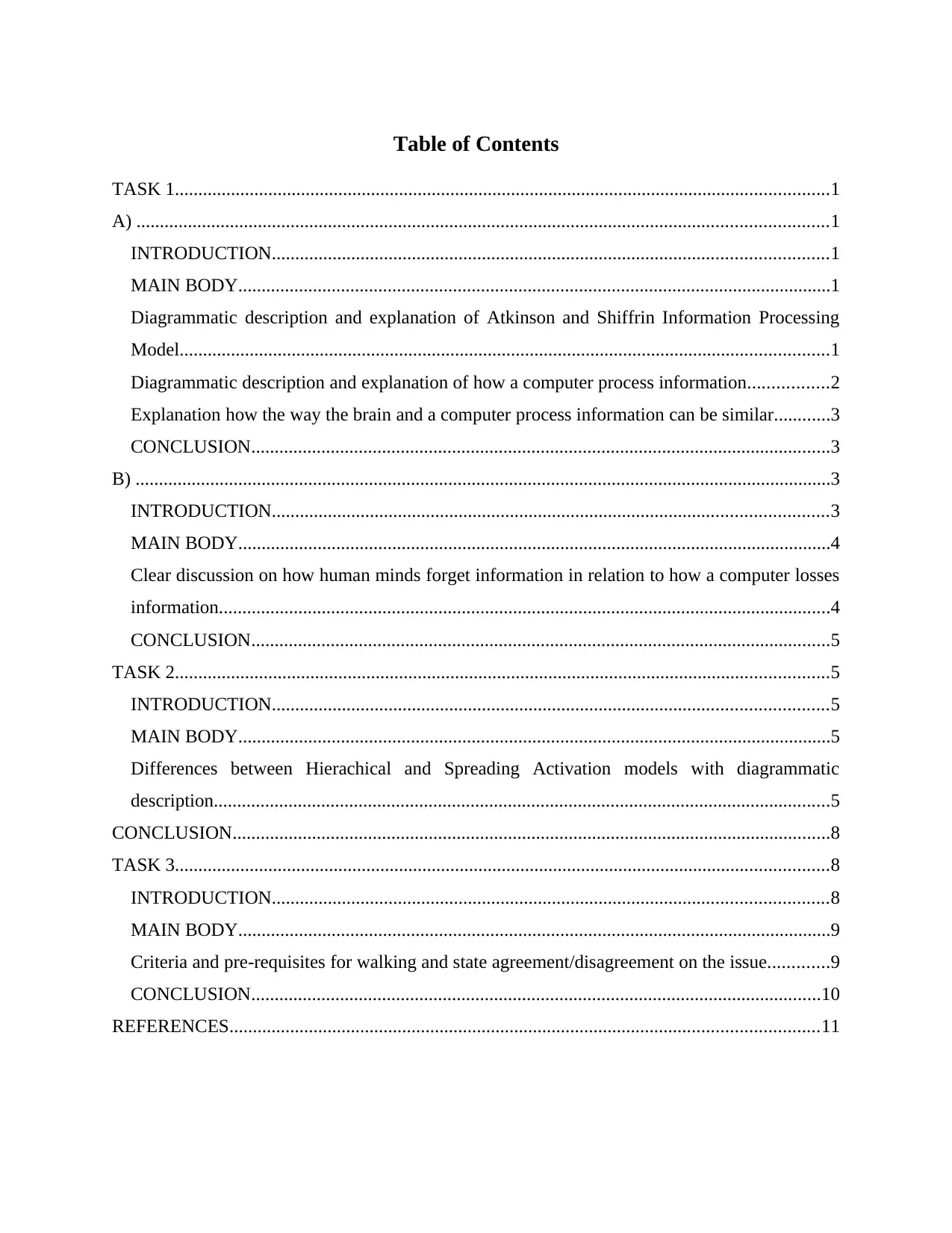
Table of Contents
TASK 1............................................................................................................................................1
A) ....................................................................................................................................................1
INTRODUCTION.......................................................................................................................1
MAIN BODY...............................................................................................................................1
Diagrammatic description and explanation of Atkinson and Shiffrin Information Processing
Model...........................................................................................................................................1
Diagrammatic description and explanation of how a computer process information.................2
Explanation how the way the brain and a computer process information can be similar............3
CONCLUSION............................................................................................................................3
B) .....................................................................................................................................................3
INTRODUCTION.......................................................................................................................3
MAIN BODY...............................................................................................................................4
Clear discussion on how human minds forget information in relation to how a computer losses
information...................................................................................................................................4
CONCLUSION............................................................................................................................5
TASK 2............................................................................................................................................5
INTRODUCTION.......................................................................................................................5
MAIN BODY...............................................................................................................................5
Differences between Hierachical and Spreading Activation models with diagrammatic
description....................................................................................................................................5
CONCLUSION................................................................................................................................8
TASK 3............................................................................................................................................8
INTRODUCTION.......................................................................................................................8
MAIN BODY...............................................................................................................................9
Criteria and pre-requisites for walking and state agreement/disagreement on the issue.............9
CONCLUSION..........................................................................................................................10
REFERENCES..............................................................................................................................11
TASK 1............................................................................................................................................1
A) ....................................................................................................................................................1
INTRODUCTION.......................................................................................................................1
MAIN BODY...............................................................................................................................1
Diagrammatic description and explanation of Atkinson and Shiffrin Information Processing
Model...........................................................................................................................................1
Diagrammatic description and explanation of how a computer process information.................2
Explanation how the way the brain and a computer process information can be similar............3
CONCLUSION............................................................................................................................3
B) .....................................................................................................................................................3
INTRODUCTION.......................................................................................................................3
MAIN BODY...............................................................................................................................4
Clear discussion on how human minds forget information in relation to how a computer losses
information...................................................................................................................................4
CONCLUSION............................................................................................................................5
TASK 2............................................................................................................................................5
INTRODUCTION.......................................................................................................................5
MAIN BODY...............................................................................................................................5
Differences between Hierachical and Spreading Activation models with diagrammatic
description....................................................................................................................................5
CONCLUSION................................................................................................................................8
TASK 3............................................................................................................................................8
INTRODUCTION.......................................................................................................................8
MAIN BODY...............................................................................................................................9
Criteria and pre-requisites for walking and state agreement/disagreement on the issue.............9
CONCLUSION..........................................................................................................................10
REFERENCES..............................................................................................................................11
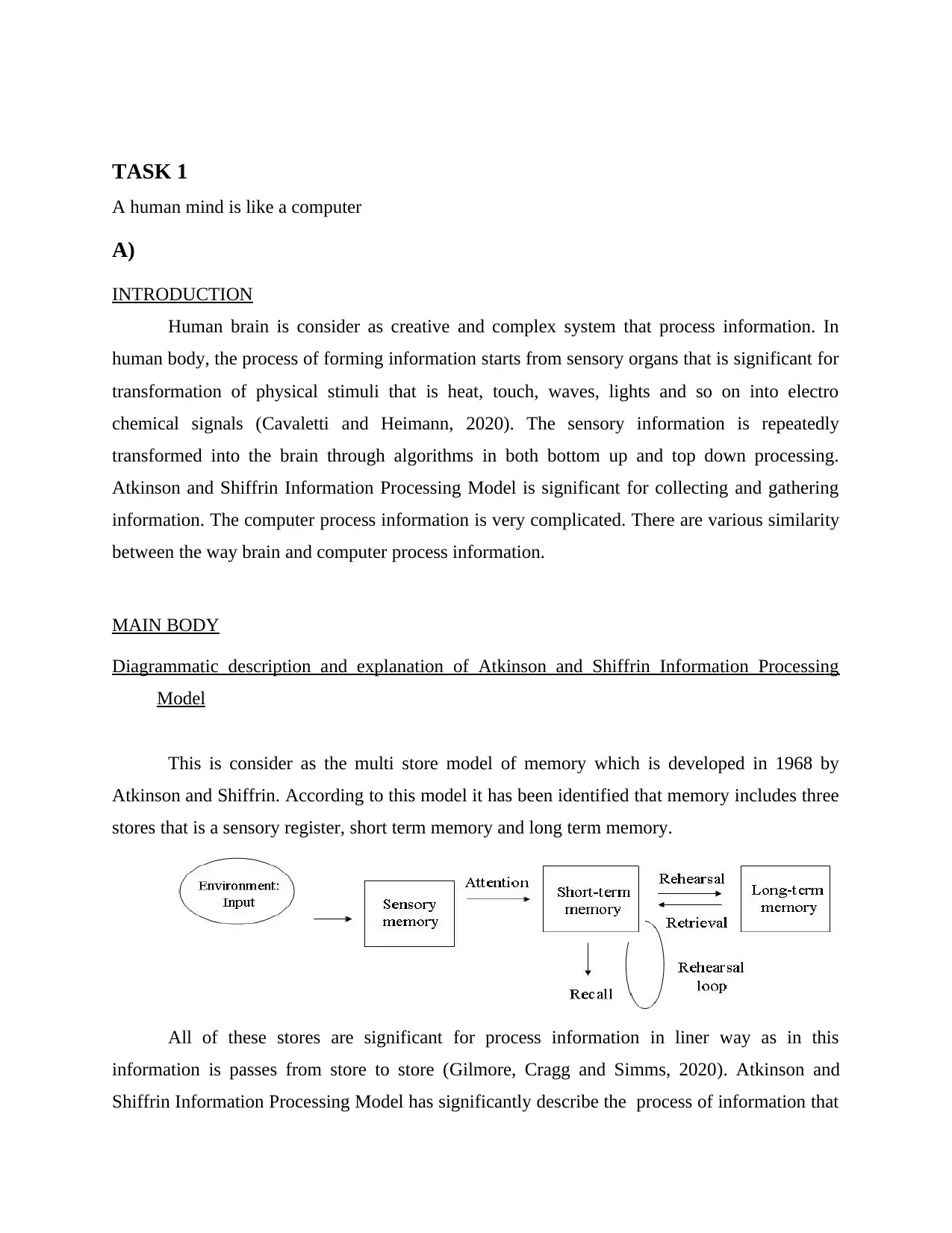
TASK 1
A human mind is like a computer
A)
INTRODUCTION
Human brain is consider as creative and complex system that process information. In
human body, the process of forming information starts from sensory organs that is significant for
transformation of physical stimuli that is heat, touch, waves, lights and so on into electro
chemical signals (Cavaletti and Heimann, 2020). The sensory information is repeatedly
transformed into the brain through algorithms in both bottom up and top down processing.
Atkinson and Shiffrin Information Processing Model is significant for collecting and gathering
information. The computer process information is very complicated. There are various similarity
between the way brain and computer process information.
MAIN BODY
Diagrammatic description and explanation of Atkinson and Shiffrin Information Processing
Model
This is consider as the multi store model of memory which is developed in 1968 by
Atkinson and Shiffrin. According to this model it has been identified that memory includes three
stores that is a sensory register, short term memory and long term memory.
All of these stores are significant for process information in liner way as in this
information is passes from store to store (Gilmore, Cragg and Simms, 2020). Atkinson and
Shiffrin Information Processing Model has significantly describe the process of information that
A human mind is like a computer
A)
INTRODUCTION
Human brain is consider as creative and complex system that process information. In
human body, the process of forming information starts from sensory organs that is significant for
transformation of physical stimuli that is heat, touch, waves, lights and so on into electro
chemical signals (Cavaletti and Heimann, 2020). The sensory information is repeatedly
transformed into the brain through algorithms in both bottom up and top down processing.
Atkinson and Shiffrin Information Processing Model is significant for collecting and gathering
information. The computer process information is very complicated. There are various similarity
between the way brain and computer process information.
MAIN BODY
Diagrammatic description and explanation of Atkinson and Shiffrin Information Processing
Model
This is consider as the multi store model of memory which is developed in 1968 by
Atkinson and Shiffrin. According to this model it has been identified that memory includes three
stores that is a sensory register, short term memory and long term memory.
All of these stores are significant for process information in liner way as in this
information is passes from store to store (Gilmore, Cragg and Simms, 2020). Atkinson and
Shiffrin Information Processing Model has significantly describe the process of information that
⊘ This is a preview!⊘
Do you want full access?
Subscribe today to unlock all pages.

Trusted by 1+ million students worldwide
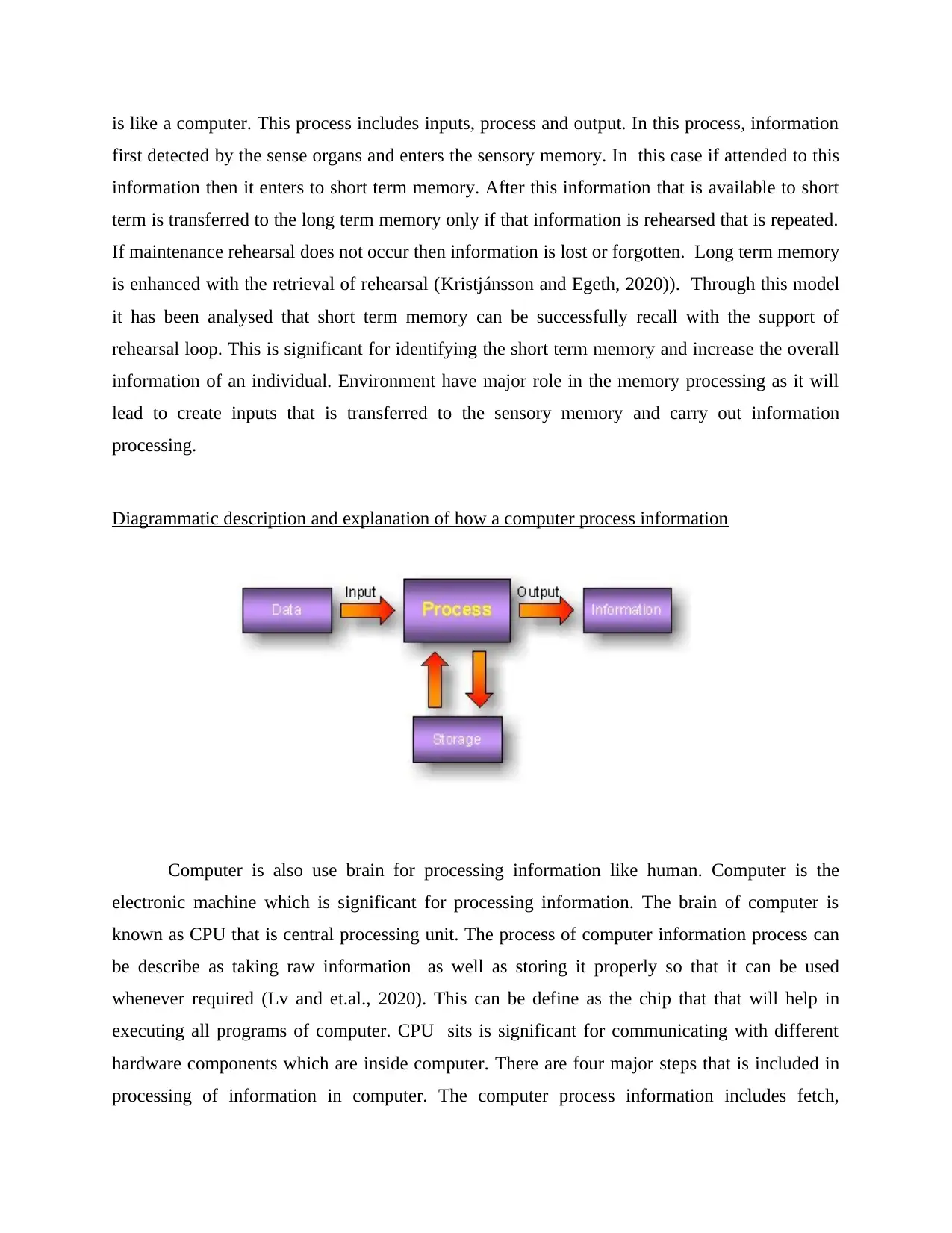
is like a computer. This process includes inputs, process and output. In this process, information
first detected by the sense organs and enters the sensory memory. In this case if attended to this
information then it enters to short term memory. After this information that is available to short
term is transferred to the long term memory only if that information is rehearsed that is repeated.
If maintenance rehearsal does not occur then information is lost or forgotten. Long term memory
is enhanced with the retrieval of rehearsal (Kristjánsson and Egeth, 2020)). Through this model
it has been analysed that short term memory can be successfully recall with the support of
rehearsal loop. This is significant for identifying the short term memory and increase the overall
information of an individual. Environment have major role in the memory processing as it will
lead to create inputs that is transferred to the sensory memory and carry out information
processing.
Diagrammatic description and explanation of how a computer process information
Computer is also use brain for processing information like human. Computer is the
electronic machine which is significant for processing information. The brain of computer is
known as CPU that is central processing unit. The process of computer information process can
be describe as taking raw information as well as storing it properly so that it can be used
whenever required (Lv and et.al., 2020). This can be define as the chip that that will help in
executing all programs of computer. CPU sits is significant for communicating with different
hardware components which are inside computer. There are four major steps that is included in
processing of information in computer. The computer process information includes fetch,
first detected by the sense organs and enters the sensory memory. In this case if attended to this
information then it enters to short term memory. After this information that is available to short
term is transferred to the long term memory only if that information is rehearsed that is repeated.
If maintenance rehearsal does not occur then information is lost or forgotten. Long term memory
is enhanced with the retrieval of rehearsal (Kristjánsson and Egeth, 2020)). Through this model
it has been analysed that short term memory can be successfully recall with the support of
rehearsal loop. This is significant for identifying the short term memory and increase the overall
information of an individual. Environment have major role in the memory processing as it will
lead to create inputs that is transferred to the sensory memory and carry out information
processing.
Diagrammatic description and explanation of how a computer process information
Computer is also use brain for processing information like human. Computer is the
electronic machine which is significant for processing information. The brain of computer is
known as CPU that is central processing unit. The process of computer information process can
be describe as taking raw information as well as storing it properly so that it can be used
whenever required (Lv and et.al., 2020). This can be define as the chip that that will help in
executing all programs of computer. CPU sits is significant for communicating with different
hardware components which are inside computer. There are four major steps that is included in
processing of information in computer. The computer process information includes fetch,
Paraphrase This Document
Need a fresh take? Get an instant paraphrase of this document with our AI Paraphraser
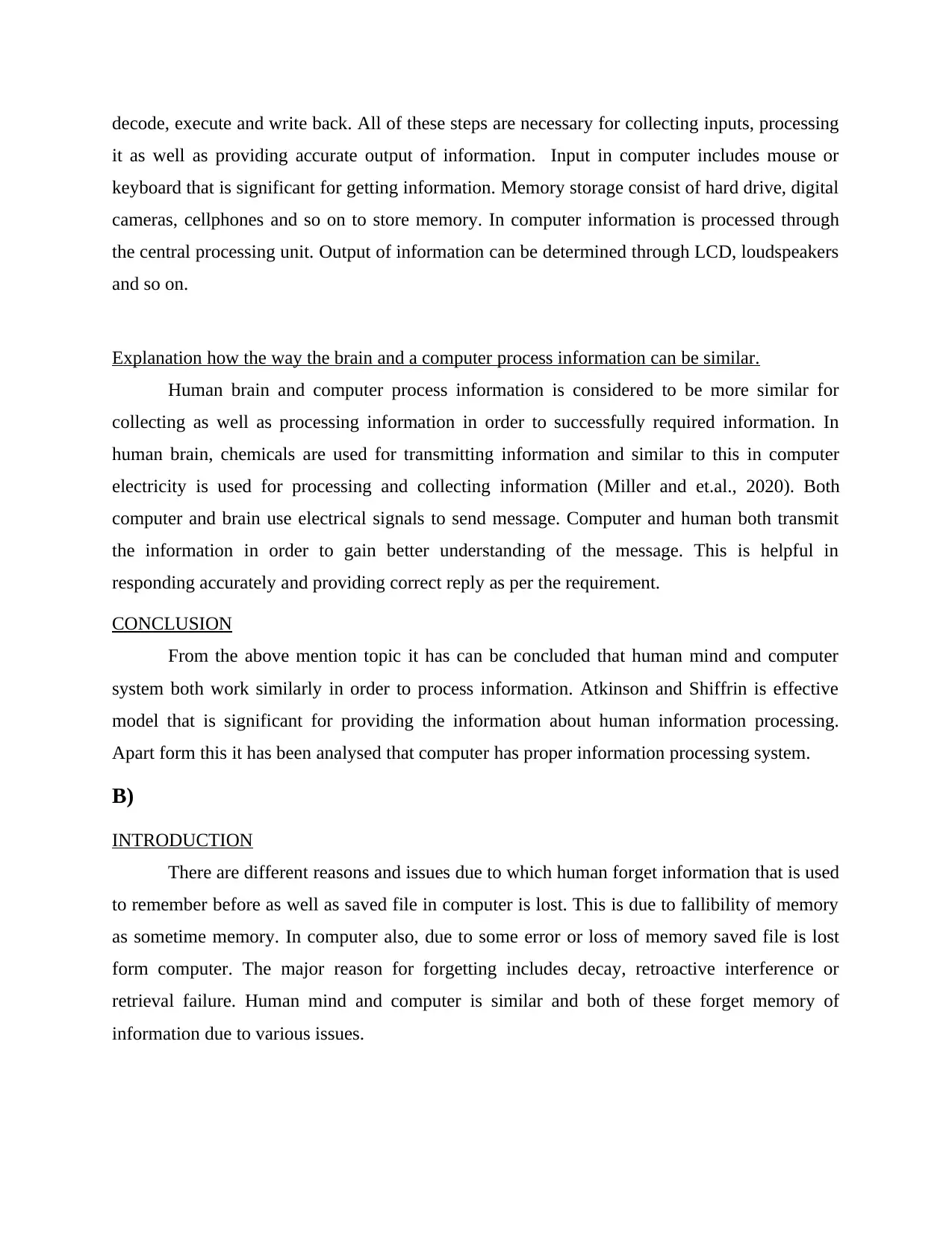
decode, execute and write back. All of these steps are necessary for collecting inputs, processing
it as well as providing accurate output of information. Input in computer includes mouse or
keyboard that is significant for getting information. Memory storage consist of hard drive, digital
cameras, cellphones and so on to store memory. In computer information is processed through
the central processing unit. Output of information can be determined through LCD, loudspeakers
and so on.
Explanation how the way the brain and a computer process information can be similar.
Human brain and computer process information is considered to be more similar for
collecting as well as processing information in order to successfully required information. In
human brain, chemicals are used for transmitting information and similar to this in computer
electricity is used for processing and collecting information (Miller and et.al., 2020). Both
computer and brain use electrical signals to send message. Computer and human both transmit
the information in order to gain better understanding of the message. This is helpful in
responding accurately and providing correct reply as per the requirement.
CONCLUSION
From the above mention topic it has can be concluded that human mind and computer
system both work similarly in order to process information. Atkinson and Shiffrin is effective
model that is significant for providing the information about human information processing.
Apart form this it has been analysed that computer has proper information processing system.
B)
INTRODUCTION
There are different reasons and issues due to which human forget information that is used
to remember before as well as saved file in computer is lost. This is due to fallibility of memory
as sometime memory. In computer also, due to some error or loss of memory saved file is lost
form computer. The major reason for forgetting includes decay, retroactive interference or
retrieval failure. Human mind and computer is similar and both of these forget memory of
information due to various issues.
it as well as providing accurate output of information. Input in computer includes mouse or
keyboard that is significant for getting information. Memory storage consist of hard drive, digital
cameras, cellphones and so on to store memory. In computer information is processed through
the central processing unit. Output of information can be determined through LCD, loudspeakers
and so on.
Explanation how the way the brain and a computer process information can be similar.
Human brain and computer process information is considered to be more similar for
collecting as well as processing information in order to successfully required information. In
human brain, chemicals are used for transmitting information and similar to this in computer
electricity is used for processing and collecting information (Miller and et.al., 2020). Both
computer and brain use electrical signals to send message. Computer and human both transmit
the information in order to gain better understanding of the message. This is helpful in
responding accurately and providing correct reply as per the requirement.
CONCLUSION
From the above mention topic it has can be concluded that human mind and computer
system both work similarly in order to process information. Atkinson and Shiffrin is effective
model that is significant for providing the information about human information processing.
Apart form this it has been analysed that computer has proper information processing system.
B)
INTRODUCTION
There are different reasons and issues due to which human forget information that is used
to remember before as well as saved file in computer is lost. This is due to fallibility of memory
as sometime memory. In computer also, due to some error or loss of memory saved file is lost
form computer. The major reason for forgetting includes decay, retroactive interference or
retrieval failure. Human mind and computer is similar and both of these forget memory of
information due to various issues.
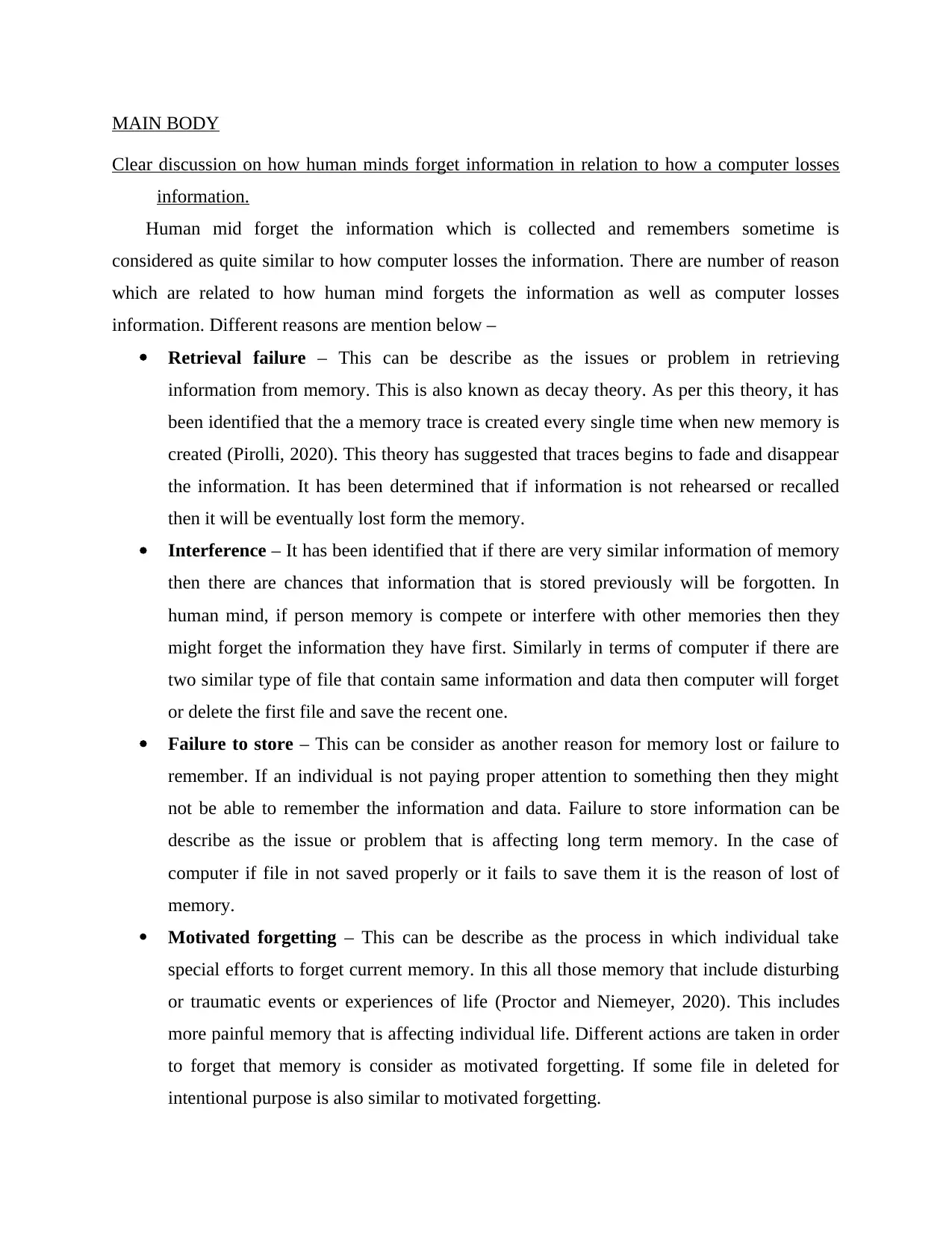
MAIN BODY
Clear discussion on how human minds forget information in relation to how a computer losses
information.
Human mid forget the information which is collected and remembers sometime is
considered as quite similar to how computer losses the information. There are number of reason
which are related to how human mind forgets the information as well as computer losses
information. Different reasons are mention below –
Retrieval failure – This can be describe as the issues or problem in retrieving
information from memory. This is also known as decay theory. As per this theory, it has
been identified that the a memory trace is created every single time when new memory is
created (Pirolli, 2020). This theory has suggested that traces begins to fade and disappear
the information. It has been determined that if information is not rehearsed or recalled
then it will be eventually lost form the memory.
Interference – It has been identified that if there are very similar information of memory
then there are chances that information that is stored previously will be forgotten. In
human mind, if person memory is compete or interfere with other memories then they
might forget the information they have first. Similarly in terms of computer if there are
two similar type of file that contain same information and data then computer will forget
or delete the first file and save the recent one.
Failure to store – This can be consider as another reason for memory lost or failure to
remember. If an individual is not paying proper attention to something then they might
not be able to remember the information and data. Failure to store information can be
describe as the issue or problem that is affecting long term memory. In the case of
computer if file in not saved properly or it fails to save them it is the reason of lost of
memory.
Motivated forgetting – This can be describe as the process in which individual take
special efforts to forget current memory. In this all those memory that include disturbing
or traumatic events or experiences of life (Proctor and Niemeyer, 2020). This includes
more painful memory that is affecting individual life. Different actions are taken in order
to forget that memory is consider as motivated forgetting. If some file in deleted for
intentional purpose is also similar to motivated forgetting.
Clear discussion on how human minds forget information in relation to how a computer losses
information.
Human mid forget the information which is collected and remembers sometime is
considered as quite similar to how computer losses the information. There are number of reason
which are related to how human mind forgets the information as well as computer losses
information. Different reasons are mention below –
Retrieval failure – This can be describe as the issues or problem in retrieving
information from memory. This is also known as decay theory. As per this theory, it has
been identified that the a memory trace is created every single time when new memory is
created (Pirolli, 2020). This theory has suggested that traces begins to fade and disappear
the information. It has been determined that if information is not rehearsed or recalled
then it will be eventually lost form the memory.
Interference – It has been identified that if there are very similar information of memory
then there are chances that information that is stored previously will be forgotten. In
human mind, if person memory is compete or interfere with other memories then they
might forget the information they have first. Similarly in terms of computer if there are
two similar type of file that contain same information and data then computer will forget
or delete the first file and save the recent one.
Failure to store – This can be consider as another reason for memory lost or failure to
remember. If an individual is not paying proper attention to something then they might
not be able to remember the information and data. Failure to store information can be
describe as the issue or problem that is affecting long term memory. In the case of
computer if file in not saved properly or it fails to save them it is the reason of lost of
memory.
Motivated forgetting – This can be describe as the process in which individual take
special efforts to forget current memory. In this all those memory that include disturbing
or traumatic events or experiences of life (Proctor and Niemeyer, 2020). This includes
more painful memory that is affecting individual life. Different actions are taken in order
to forget that memory is consider as motivated forgetting. If some file in deleted for
intentional purpose is also similar to motivated forgetting.
⊘ This is a preview!⊘
Do you want full access?
Subscribe today to unlock all pages.

Trusted by 1+ million students worldwide
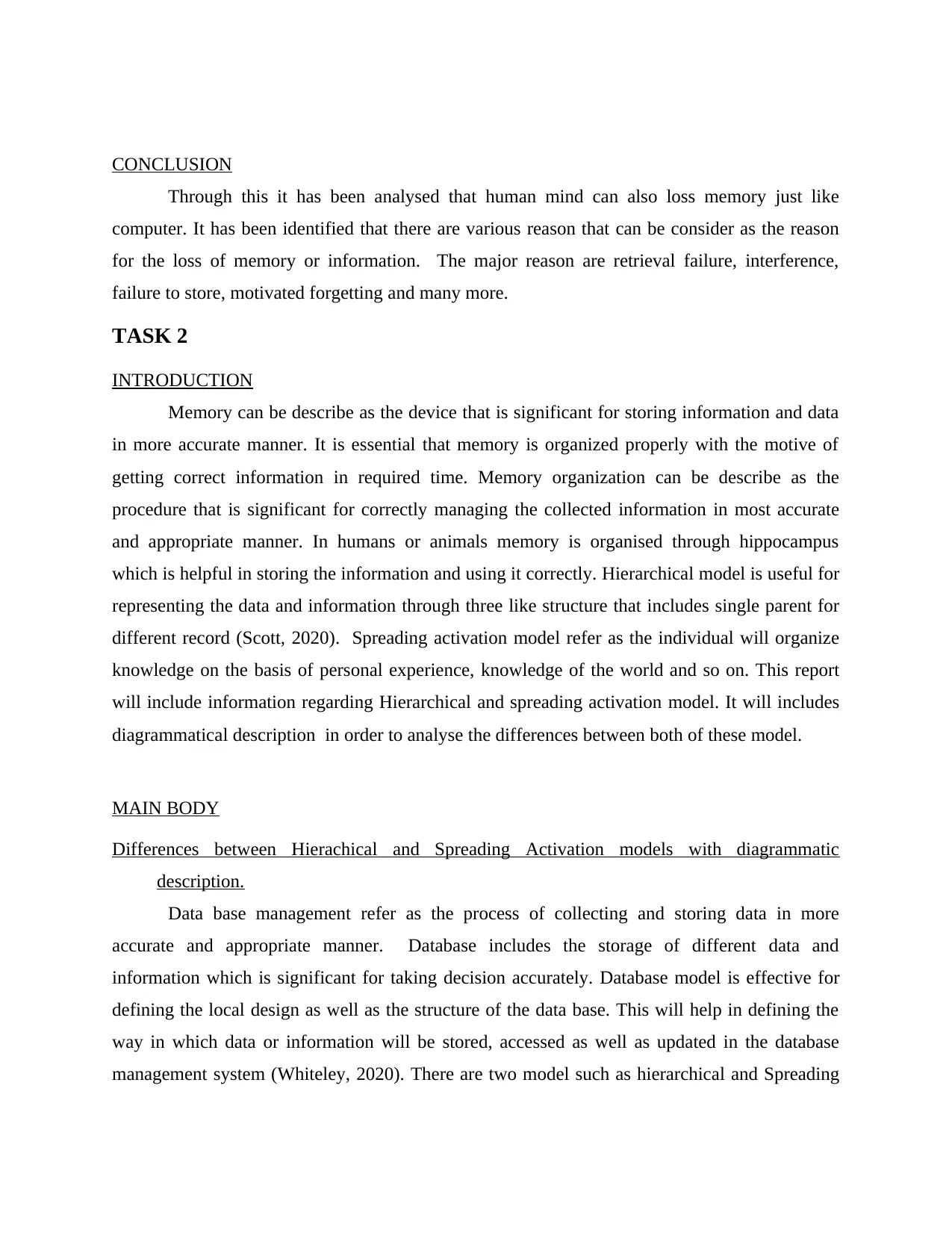
CONCLUSION
Through this it has been analysed that human mind can also loss memory just like
computer. It has been identified that there are various reason that can be consider as the reason
for the loss of memory or information. The major reason are retrieval failure, interference,
failure to store, motivated forgetting and many more.
TASK 2
INTRODUCTION
Memory can be describe as the device that is significant for storing information and data
in more accurate manner. It is essential that memory is organized properly with the motive of
getting correct information in required time. Memory organization can be describe as the
procedure that is significant for correctly managing the collected information in most accurate
and appropriate manner. In humans or animals memory is organised through hippocampus
which is helpful in storing the information and using it correctly. Hierarchical model is useful for
representing the data and information through three like structure that includes single parent for
different record (Scott, 2020). Spreading activation model refer as the individual will organize
knowledge on the basis of personal experience, knowledge of the world and so on. This report
will include information regarding Hierarchical and spreading activation model. It will includes
diagrammatical description in order to analyse the differences between both of these model.
MAIN BODY
Differences between Hierachical and Spreading Activation models with diagrammatic
description.
Data base management refer as the process of collecting and storing data in more
accurate and appropriate manner. Database includes the storage of different data and
information which is significant for taking decision accurately. Database model is effective for
defining the local design as well as the structure of the data base. This will help in defining the
way in which data or information will be stored, accessed as well as updated in the database
management system (Whiteley, 2020). There are two model such as hierarchical and Spreading
Through this it has been analysed that human mind can also loss memory just like
computer. It has been identified that there are various reason that can be consider as the reason
for the loss of memory or information. The major reason are retrieval failure, interference,
failure to store, motivated forgetting and many more.
TASK 2
INTRODUCTION
Memory can be describe as the device that is significant for storing information and data
in more accurate manner. It is essential that memory is organized properly with the motive of
getting correct information in required time. Memory organization can be describe as the
procedure that is significant for correctly managing the collected information in most accurate
and appropriate manner. In humans or animals memory is organised through hippocampus
which is helpful in storing the information and using it correctly. Hierarchical model is useful for
representing the data and information through three like structure that includes single parent for
different record (Scott, 2020). Spreading activation model refer as the individual will organize
knowledge on the basis of personal experience, knowledge of the world and so on. This report
will include information regarding Hierarchical and spreading activation model. It will includes
diagrammatical description in order to analyse the differences between both of these model.
MAIN BODY
Differences between Hierachical and Spreading Activation models with diagrammatic
description.
Data base management refer as the process of collecting and storing data in more
accurate and appropriate manner. Database includes the storage of different data and
information which is significant for taking decision accurately. Database model is effective for
defining the local design as well as the structure of the data base. This will help in defining the
way in which data or information will be stored, accessed as well as updated in the database
management system (Whiteley, 2020). There are two model such as hierarchical and Spreading
Paraphrase This Document
Need a fresh take? Get an instant paraphrase of this document with our AI Paraphraser
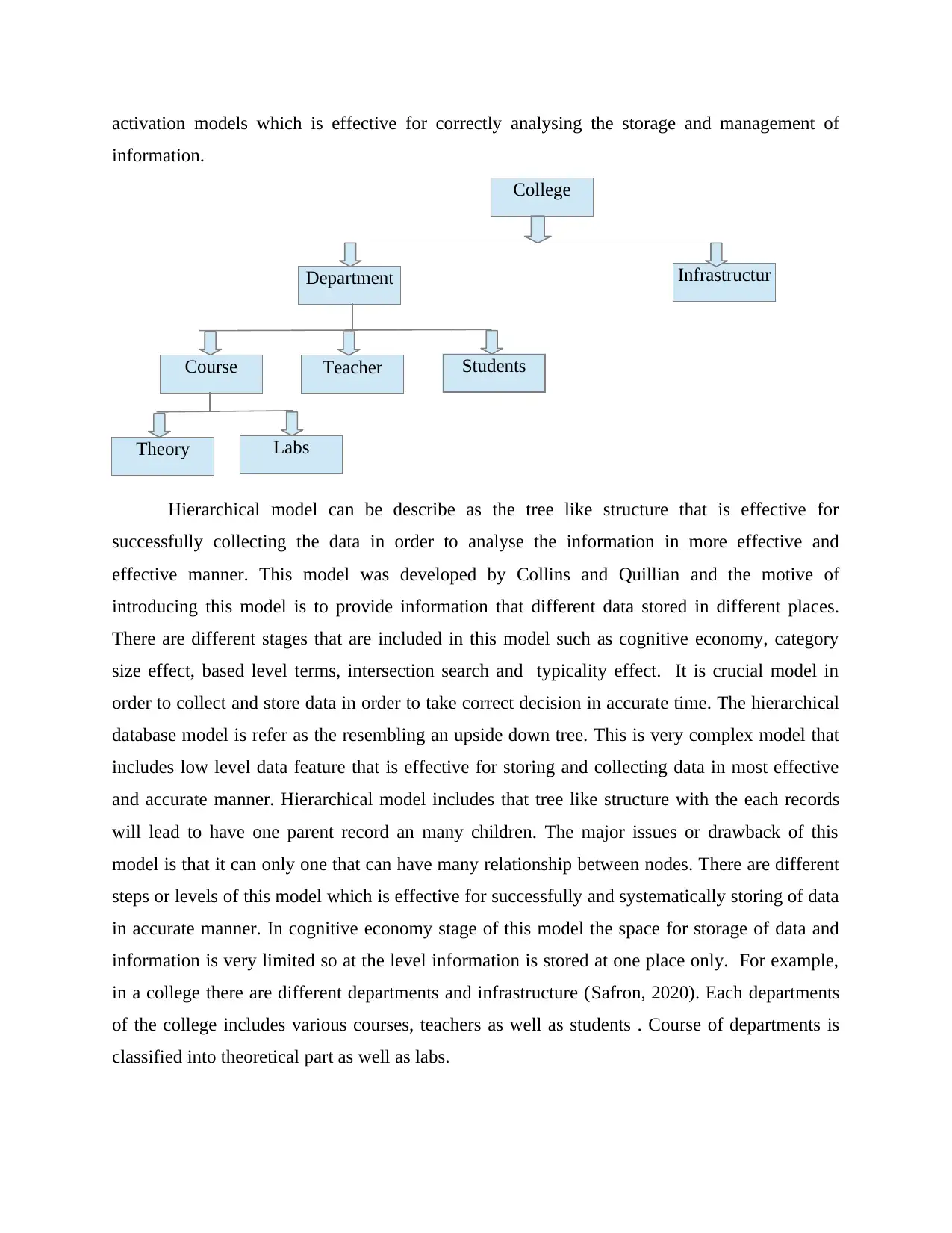
activation models which is effective for correctly analysing the storage and management of
information.
Hierarchical model can be describe as the tree like structure that is effective for
successfully collecting the data in order to analyse the information in more effective and
effective manner. This model was developed by Collins and Quillian and the motive of
introducing this model is to provide information that different data stored in different places.
There are different stages that are included in this model such as cognitive economy, category
size effect, based level terms, intersection search and typicality effect. It is crucial model in
order to collect and store data in order to take correct decision in accurate time. The hierarchical
database model is refer as the resembling an upside down tree. This is very complex model that
includes low level data feature that is effective for storing and collecting data in most effective
and accurate manner. Hierarchical model includes that tree like structure with the each records
will lead to have one parent record an many children. The major issues or drawback of this
model is that it can only one that can have many relationship between nodes. There are different
steps or levels of this model which is effective for successfully and systematically storing of data
in accurate manner. In cognitive economy stage of this model the space for storage of data and
information is very limited so at the level information is stored at one place only. For example,
in a college there are different departments and infrastructure (Safron, 2020). Each departments
of the college includes various courses, teachers as well as students . Course of departments is
classified into theoretical part as well as labs.
College
Department
Course
Infrastructur
e
Teacher Students
Theory Labs
information.
Hierarchical model can be describe as the tree like structure that is effective for
successfully collecting the data in order to analyse the information in more effective and
effective manner. This model was developed by Collins and Quillian and the motive of
introducing this model is to provide information that different data stored in different places.
There are different stages that are included in this model such as cognitive economy, category
size effect, based level terms, intersection search and typicality effect. It is crucial model in
order to collect and store data in order to take correct decision in accurate time. The hierarchical
database model is refer as the resembling an upside down tree. This is very complex model that
includes low level data feature that is effective for storing and collecting data in most effective
and accurate manner. Hierarchical model includes that tree like structure with the each records
will lead to have one parent record an many children. The major issues or drawback of this
model is that it can only one that can have many relationship between nodes. There are different
steps or levels of this model which is effective for successfully and systematically storing of data
in accurate manner. In cognitive economy stage of this model the space for storage of data and
information is very limited so at the level information is stored at one place only. For example,
in a college there are different departments and infrastructure (Safron, 2020). Each departments
of the college includes various courses, teachers as well as students . Course of departments is
classified into theoretical part as well as labs.
College
Department
Course
Infrastructur
e
Teacher Students
Theory Labs
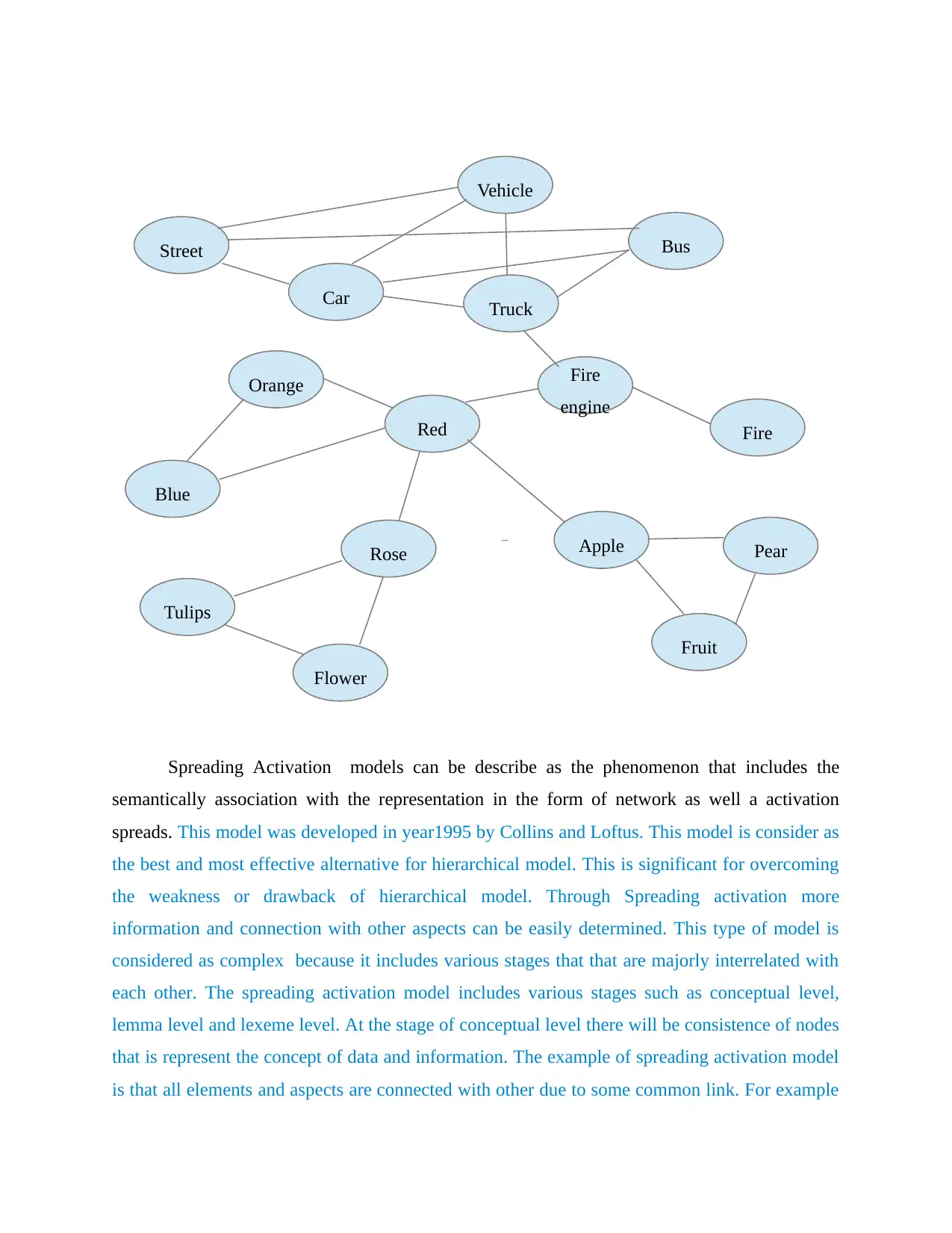
Spreading Activation models can be describe as the phenomenon that includes the
semantically association with the representation in the form of network as well a activation
spreads. This model was developed in year1995 by Collins and Loftus. This model is consider as
the best and most effective alternative for hierarchical model. This is significant for overcoming
the weakness or drawback of hierarchical model. Through Spreading activation more
information and connection with other aspects can be easily determined. This type of model is
considered as complex because it includes various stages that that are majorly interrelated with
each other. The spreading activation model includes various stages such as conceptual level,
lemma level and lexeme level. At the stage of conceptual level there will be consistence of nodes
that is represent the concept of data and information. The example of spreading activation model
is that all elements and aspects are connected with other due to some common link. For example
Red
Vehicle
Truck
Car
BusStreet
Fire
Orange Fire
engine
Blue
AppleRose
Fruit
Tulips
Flower
Pear
semantically association with the representation in the form of network as well a activation
spreads. This model was developed in year1995 by Collins and Loftus. This model is consider as
the best and most effective alternative for hierarchical model. This is significant for overcoming
the weakness or drawback of hierarchical model. Through Spreading activation more
information and connection with other aspects can be easily determined. This type of model is
considered as complex because it includes various stages that that are majorly interrelated with
each other. The spreading activation model includes various stages such as conceptual level,
lemma level and lexeme level. At the stage of conceptual level there will be consistence of nodes
that is represent the concept of data and information. The example of spreading activation model
is that all elements and aspects are connected with other due to some common link. For example
Red
Vehicle
Truck
Car
BusStreet
Fire
Orange Fire
engine
Blue
AppleRose
Fruit
Tulips
Flower
Pear
⊘ This is a preview!⊘
Do you want full access?
Subscribe today to unlock all pages.

Trusted by 1+ million students worldwide
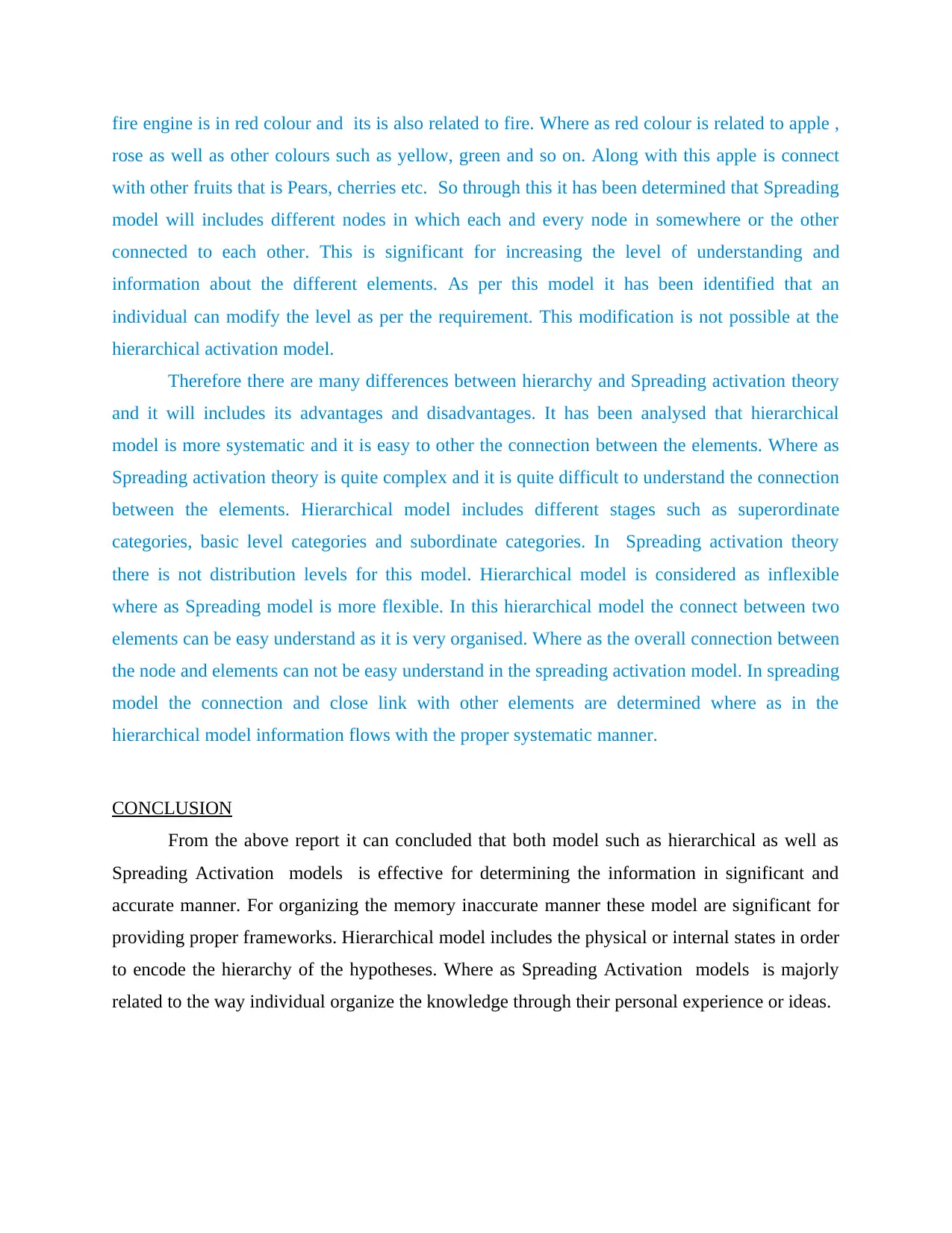
fire engine is in red colour and its is also related to fire. Where as red colour is related to apple ,
rose as well as other colours such as yellow, green and so on. Along with this apple is connect
with other fruits that is Pears, cherries etc. So through this it has been determined that Spreading
model will includes different nodes in which each and every node in somewhere or the other
connected to each other. This is significant for increasing the level of understanding and
information about the different elements. As per this model it has been identified that an
individual can modify the level as per the requirement. This modification is not possible at the
hierarchical activation model.
Therefore there are many differences between hierarchy and Spreading activation theory
and it will includes its advantages and disadvantages. It has been analysed that hierarchical
model is more systematic and it is easy to other the connection between the elements. Where as
Spreading activation theory is quite complex and it is quite difficult to understand the connection
between the elements. Hierarchical model includes different stages such as superordinate
categories, basic level categories and subordinate categories. In Spreading activation theory
there is not distribution levels for this model. Hierarchical model is considered as inflexible
where as Spreading model is more flexible. In this hierarchical model the connect between two
elements can be easy understand as it is very organised. Where as the overall connection between
the node and elements can not be easy understand in the spreading activation model. In spreading
model the connection and close link with other elements are determined where as in the
hierarchical model information flows with the proper systematic manner.
CONCLUSION
From the above report it can concluded that both model such as hierarchical as well as
Spreading Activation models is effective for determining the information in significant and
accurate manner. For organizing the memory inaccurate manner these model are significant for
providing proper frameworks. Hierarchical model includes the physical or internal states in order
to encode the hierarchy of the hypotheses. Where as Spreading Activation models is majorly
related to the way individual organize the knowledge through their personal experience or ideas.
rose as well as other colours such as yellow, green and so on. Along with this apple is connect
with other fruits that is Pears, cherries etc. So through this it has been determined that Spreading
model will includes different nodes in which each and every node in somewhere or the other
connected to each other. This is significant for increasing the level of understanding and
information about the different elements. As per this model it has been identified that an
individual can modify the level as per the requirement. This modification is not possible at the
hierarchical activation model.
Therefore there are many differences between hierarchy and Spreading activation theory
and it will includes its advantages and disadvantages. It has been analysed that hierarchical
model is more systematic and it is easy to other the connection between the elements. Where as
Spreading activation theory is quite complex and it is quite difficult to understand the connection
between the elements. Hierarchical model includes different stages such as superordinate
categories, basic level categories and subordinate categories. In Spreading activation theory
there is not distribution levels for this model. Hierarchical model is considered as inflexible
where as Spreading model is more flexible. In this hierarchical model the connect between two
elements can be easy understand as it is very organised. Where as the overall connection between
the node and elements can not be easy understand in the spreading activation model. In spreading
model the connection and close link with other elements are determined where as in the
hierarchical model information flows with the proper systematic manner.
CONCLUSION
From the above report it can concluded that both model such as hierarchical as well as
Spreading Activation models is effective for determining the information in significant and
accurate manner. For organizing the memory inaccurate manner these model are significant for
providing proper frameworks. Hierarchical model includes the physical or internal states in order
to encode the hierarchy of the hypotheses. Where as Spreading Activation models is majorly
related to the way individual organize the knowledge through their personal experience or ideas.
Paraphrase This Document
Need a fresh take? Get an instant paraphrase of this document with our AI Paraphraser
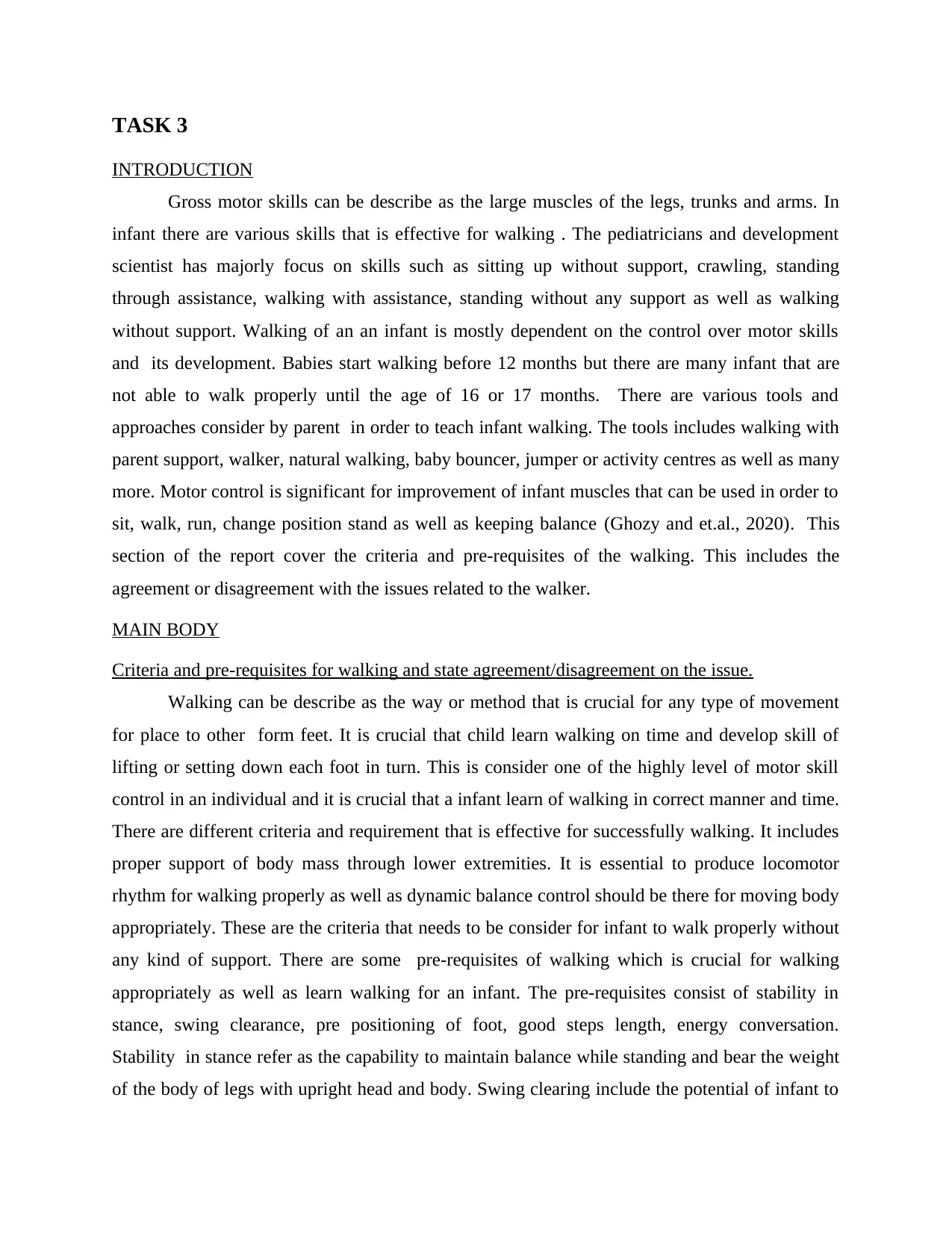
TASK 3
INTRODUCTION
Gross motor skills can be describe as the large muscles of the legs, trunks and arms. In
infant there are various skills that is effective for walking . The pediatricians and development
scientist has majorly focus on skills such as sitting up without support, crawling, standing
through assistance, walking with assistance, standing without any support as well as walking
without support. Walking of an an infant is mostly dependent on the control over motor skills
and its development. Babies start walking before 12 months but there are many infant that are
not able to walk properly until the age of 16 or 17 months. There are various tools and
approaches consider by parent in order to teach infant walking. The tools includes walking with
parent support, walker, natural walking, baby bouncer, jumper or activity centres as well as many
more. Motor control is significant for improvement of infant muscles that can be used in order to
sit, walk, run, change position stand as well as keeping balance (Ghozy and et.al., 2020). This
section of the report cover the criteria and pre-requisites of the walking. This includes the
agreement or disagreement with the issues related to the walker.
MAIN BODY
Criteria and pre-requisites for walking and state agreement/disagreement on the issue.
Walking can be describe as the way or method that is crucial for any type of movement
for place to other form feet. It is crucial that child learn walking on time and develop skill of
lifting or setting down each foot in turn. This is consider one of the highly level of motor skill
control in an individual and it is crucial that a infant learn of walking in correct manner and time.
There are different criteria and requirement that is effective for successfully walking. It includes
proper support of body mass through lower extremities. It is essential to produce locomotor
rhythm for walking properly as well as dynamic balance control should be there for moving body
appropriately. These are the criteria that needs to be consider for infant to walk properly without
any kind of support. There are some pre-requisites of walking which is crucial for walking
appropriately as well as learn walking for an infant. The pre-requisites consist of stability in
stance, swing clearance, pre positioning of foot, good steps length, energy conversation.
Stability in stance refer as the capability to maintain balance while standing and bear the weight
of the body of legs with upright head and body. Swing clearing include the potential of infant to
INTRODUCTION
Gross motor skills can be describe as the large muscles of the legs, trunks and arms. In
infant there are various skills that is effective for walking . The pediatricians and development
scientist has majorly focus on skills such as sitting up without support, crawling, standing
through assistance, walking with assistance, standing without any support as well as walking
without support. Walking of an an infant is mostly dependent on the control over motor skills
and its development. Babies start walking before 12 months but there are many infant that are
not able to walk properly until the age of 16 or 17 months. There are various tools and
approaches consider by parent in order to teach infant walking. The tools includes walking with
parent support, walker, natural walking, baby bouncer, jumper or activity centres as well as many
more. Motor control is significant for improvement of infant muscles that can be used in order to
sit, walk, run, change position stand as well as keeping balance (Ghozy and et.al., 2020). This
section of the report cover the criteria and pre-requisites of the walking. This includes the
agreement or disagreement with the issues related to the walker.
MAIN BODY
Criteria and pre-requisites for walking and state agreement/disagreement on the issue.
Walking can be describe as the way or method that is crucial for any type of movement
for place to other form feet. It is crucial that child learn walking on time and develop skill of
lifting or setting down each foot in turn. This is consider one of the highly level of motor skill
control in an individual and it is crucial that a infant learn of walking in correct manner and time.
There are different criteria and requirement that is effective for successfully walking. It includes
proper support of body mass through lower extremities. It is essential to produce locomotor
rhythm for walking properly as well as dynamic balance control should be there for moving body
appropriately. These are the criteria that needs to be consider for infant to walk properly without
any kind of support. There are some pre-requisites of walking which is crucial for walking
appropriately as well as learn walking for an infant. The pre-requisites consist of stability in
stance, swing clearance, pre positioning of foot, good steps length, energy conversation.
Stability in stance refer as the capability to maintain balance while standing and bear the weight
of the body of legs with upright head and body. Swing clearing include the potential of infant to
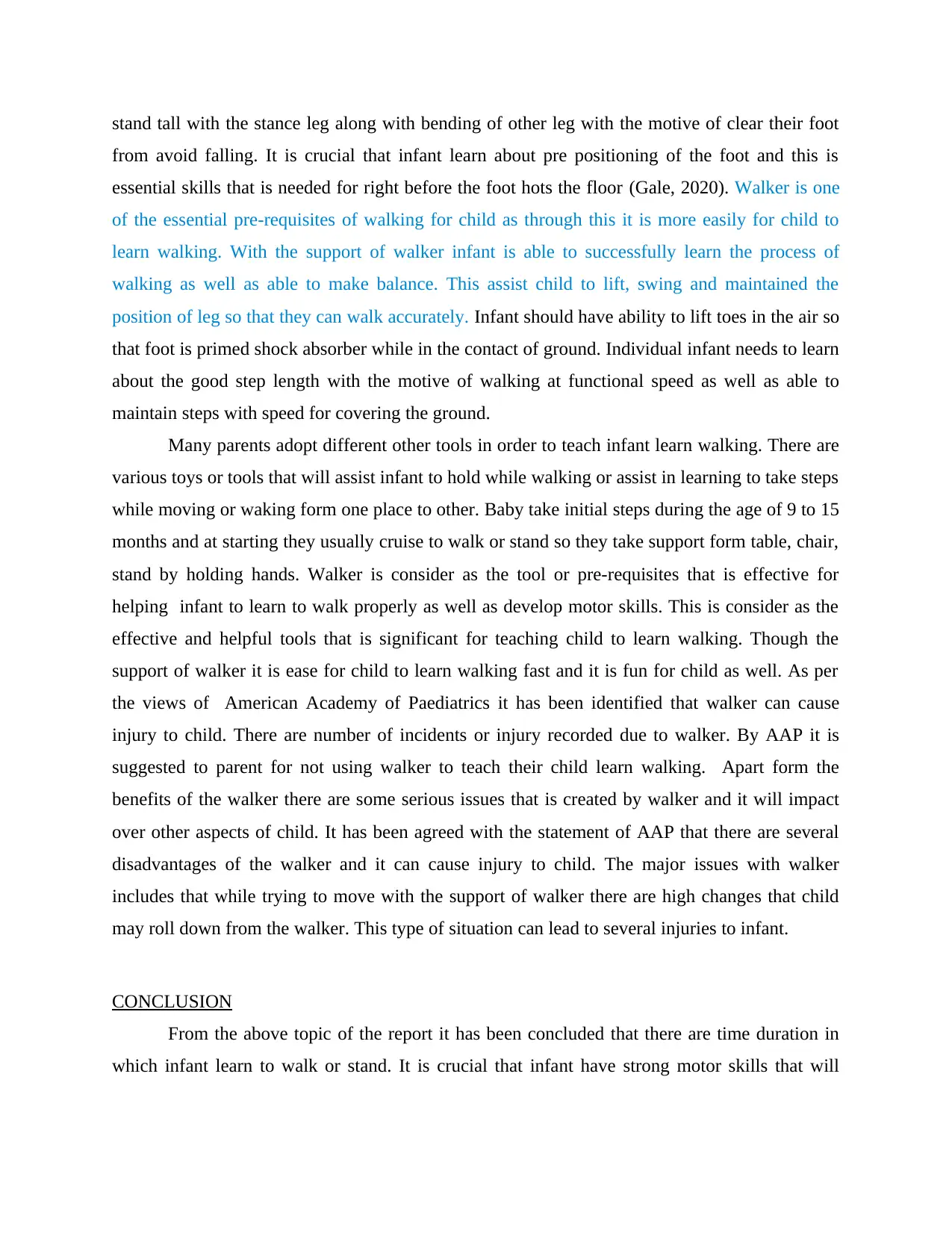
stand tall with the stance leg along with bending of other leg with the motive of clear their foot
from avoid falling. It is crucial that infant learn about pre positioning of the foot and this is
essential skills that is needed for right before the foot hots the floor (Gale, 2020). Walker is one
of the essential pre-requisites of walking for child as through this it is more easily for child to
learn walking. With the support of walker infant is able to successfully learn the process of
walking as well as able to make balance. This assist child to lift, swing and maintained the
position of leg so that they can walk accurately. Infant should have ability to lift toes in the air so
that foot is primed shock absorber while in the contact of ground. Individual infant needs to learn
about the good step length with the motive of walking at functional speed as well as able to
maintain steps with speed for covering the ground.
Many parents adopt different other tools in order to teach infant learn walking. There are
various toys or tools that will assist infant to hold while walking or assist in learning to take steps
while moving or waking form one place to other. Baby take initial steps during the age of 9 to 15
months and at starting they usually cruise to walk or stand so they take support form table, chair,
stand by holding hands. Walker is consider as the tool or pre-requisites that is effective for
helping infant to learn to walk properly as well as develop motor skills. This is consider as the
effective and helpful tools that is significant for teaching child to learn walking. Though the
support of walker it is ease for child to learn walking fast and it is fun for child as well. As per
the views of American Academy of Paediatrics it has been identified that walker can cause
injury to child. There are number of incidents or injury recorded due to walker. By AAP it is
suggested to parent for not using walker to teach their child learn walking. Apart form the
benefits of the walker there are some serious issues that is created by walker and it will impact
over other aspects of child. It has been agreed with the statement of AAP that there are several
disadvantages of the walker and it can cause injury to child. The major issues with walker
includes that while trying to move with the support of walker there are high changes that child
may roll down from the walker. This type of situation can lead to several injuries to infant.
CONCLUSION
From the above topic of the report it has been concluded that there are time duration in
which infant learn to walk or stand. It is crucial that infant have strong motor skills that will
from avoid falling. It is crucial that infant learn about pre positioning of the foot and this is
essential skills that is needed for right before the foot hots the floor (Gale, 2020). Walker is one
of the essential pre-requisites of walking for child as through this it is more easily for child to
learn walking. With the support of walker infant is able to successfully learn the process of
walking as well as able to make balance. This assist child to lift, swing and maintained the
position of leg so that they can walk accurately. Infant should have ability to lift toes in the air so
that foot is primed shock absorber while in the contact of ground. Individual infant needs to learn
about the good step length with the motive of walking at functional speed as well as able to
maintain steps with speed for covering the ground.
Many parents adopt different other tools in order to teach infant learn walking. There are
various toys or tools that will assist infant to hold while walking or assist in learning to take steps
while moving or waking form one place to other. Baby take initial steps during the age of 9 to 15
months and at starting they usually cruise to walk or stand so they take support form table, chair,
stand by holding hands. Walker is consider as the tool or pre-requisites that is effective for
helping infant to learn to walk properly as well as develop motor skills. This is consider as the
effective and helpful tools that is significant for teaching child to learn walking. Though the
support of walker it is ease for child to learn walking fast and it is fun for child as well. As per
the views of American Academy of Paediatrics it has been identified that walker can cause
injury to child. There are number of incidents or injury recorded due to walker. By AAP it is
suggested to parent for not using walker to teach their child learn walking. Apart form the
benefits of the walker there are some serious issues that is created by walker and it will impact
over other aspects of child. It has been agreed with the statement of AAP that there are several
disadvantages of the walker and it can cause injury to child. The major issues with walker
includes that while trying to move with the support of walker there are high changes that child
may roll down from the walker. This type of situation can lead to several injuries to infant.
CONCLUSION
From the above topic of the report it has been concluded that there are time duration in
which infant learn to walk or stand. It is crucial that infant have strong motor skills that will
⊘ This is a preview!⊘
Do you want full access?
Subscribe today to unlock all pages.

Trusted by 1+ million students worldwide
1 out of 14
Related Documents
Your All-in-One AI-Powered Toolkit for Academic Success.
+13062052269
info@desklib.com
Available 24*7 on WhatsApp / Email
![[object Object]](/_next/static/media/star-bottom.7253800d.svg)
Unlock your academic potential
Copyright © 2020–2025 A2Z Services. All Rights Reserved. Developed and managed by ZUCOL.




